Finally! Raymarine SeaTalk NG to NMEA 2000 backbone adapters
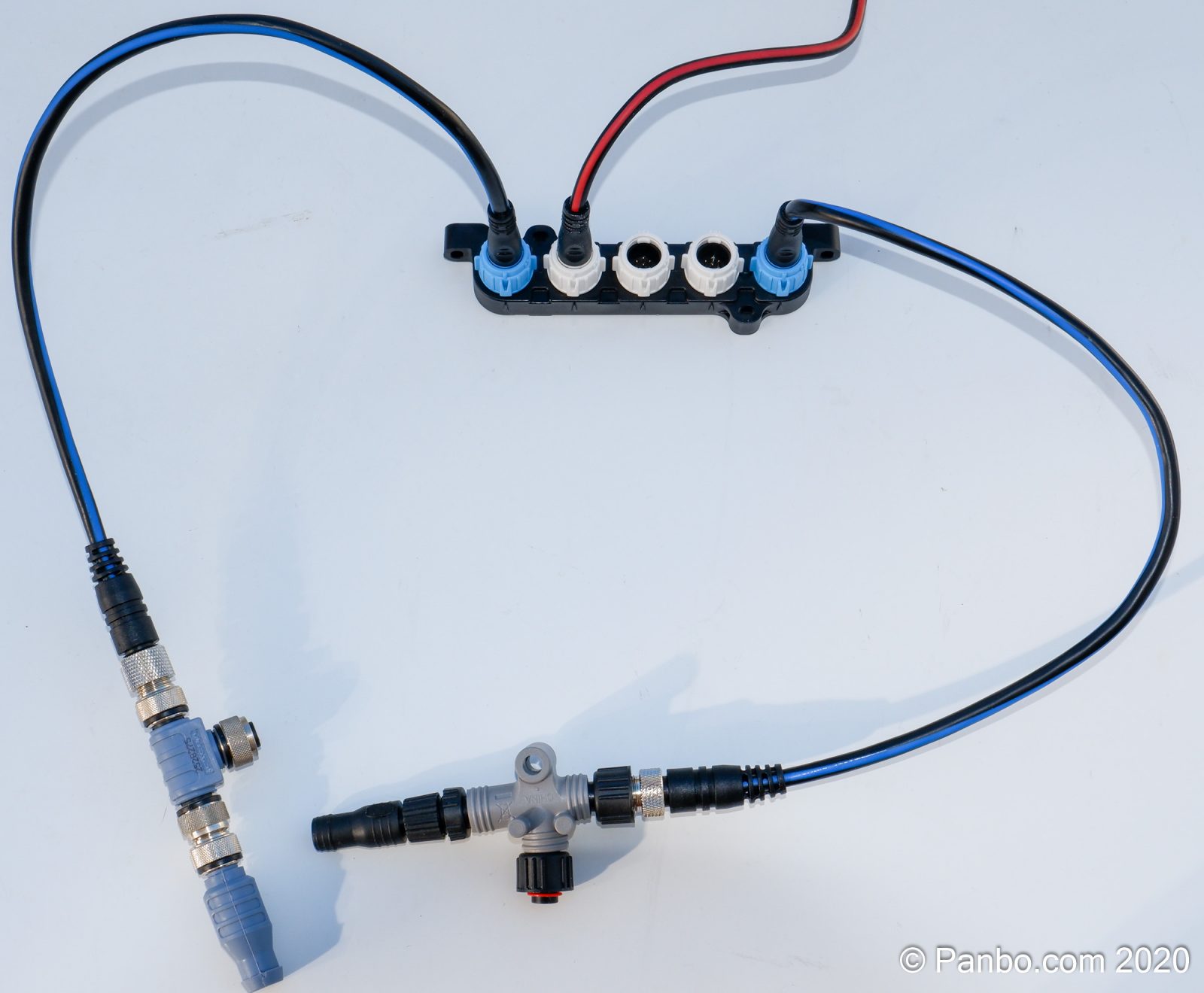
Raymarine’s SeaTalkNG is Raymarine’s proprietary version of NMEA 2000 cabling. It’s compatible with NMEA 2000’s standard DeviceNet cabling through the use of adapters. But, until very recently, Raymarine has not offered an adapter to convert the blue-striped SeaTalkNG (STng) backbone cables, only the white-striped spur cables. Good news! Raymarine now offers cables that adapt STng backbone to male (Raymarine Part number A80674) and female (A80675) N2K connectors.
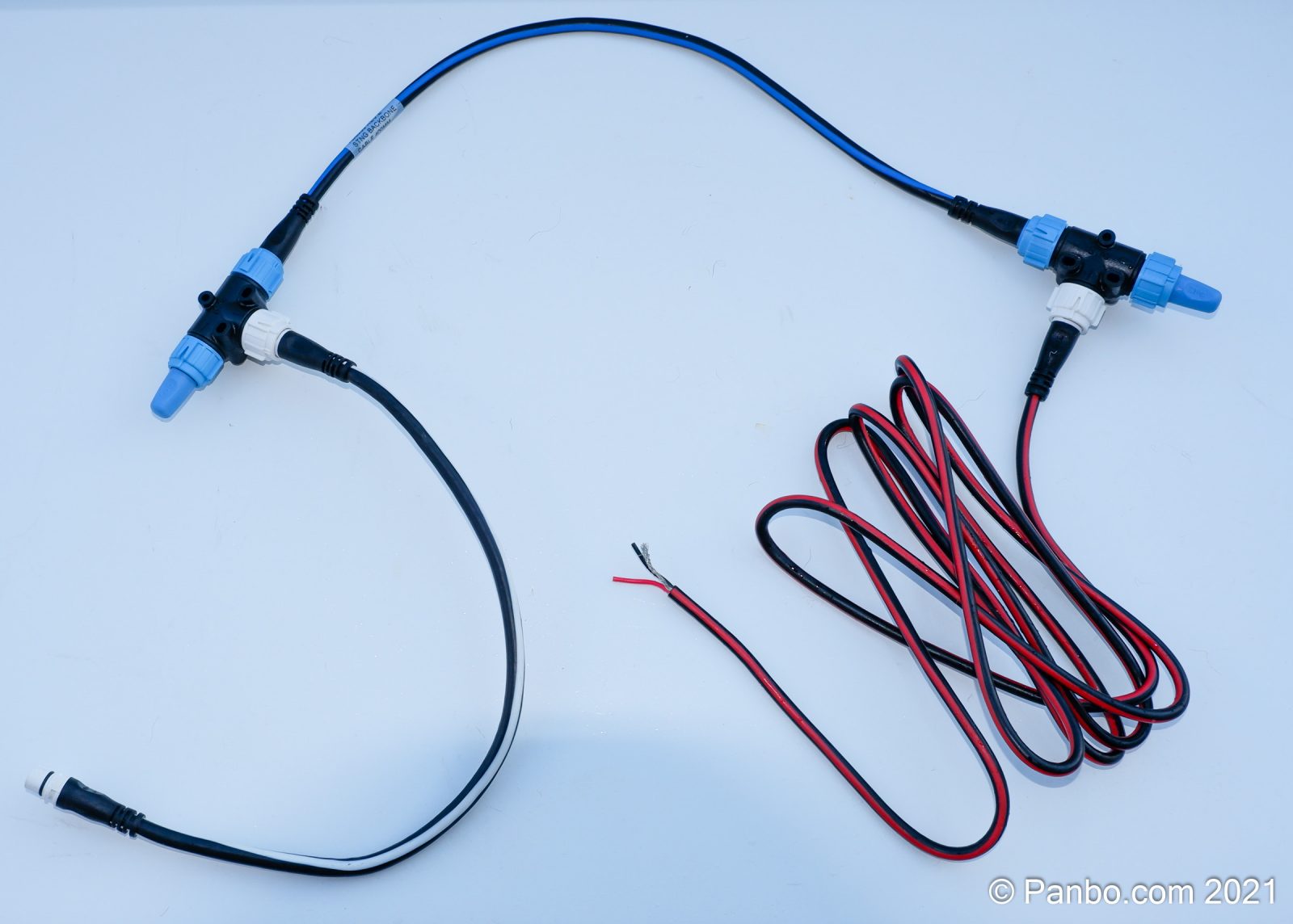
In a departure from NMEA 2000 standard cabling, SeaTalkNG uses separate backbone and spur cables. The backbone cables have a blue stripe and blue ends on the connectors while the spur cables have a white stripe and white connector. Sockets on STng devices and tee connectors have blue and white locking collars to indicate the cable type. Backbone cables won’t fit in spur sockets and nor will spur cables fit in backbone sockets.
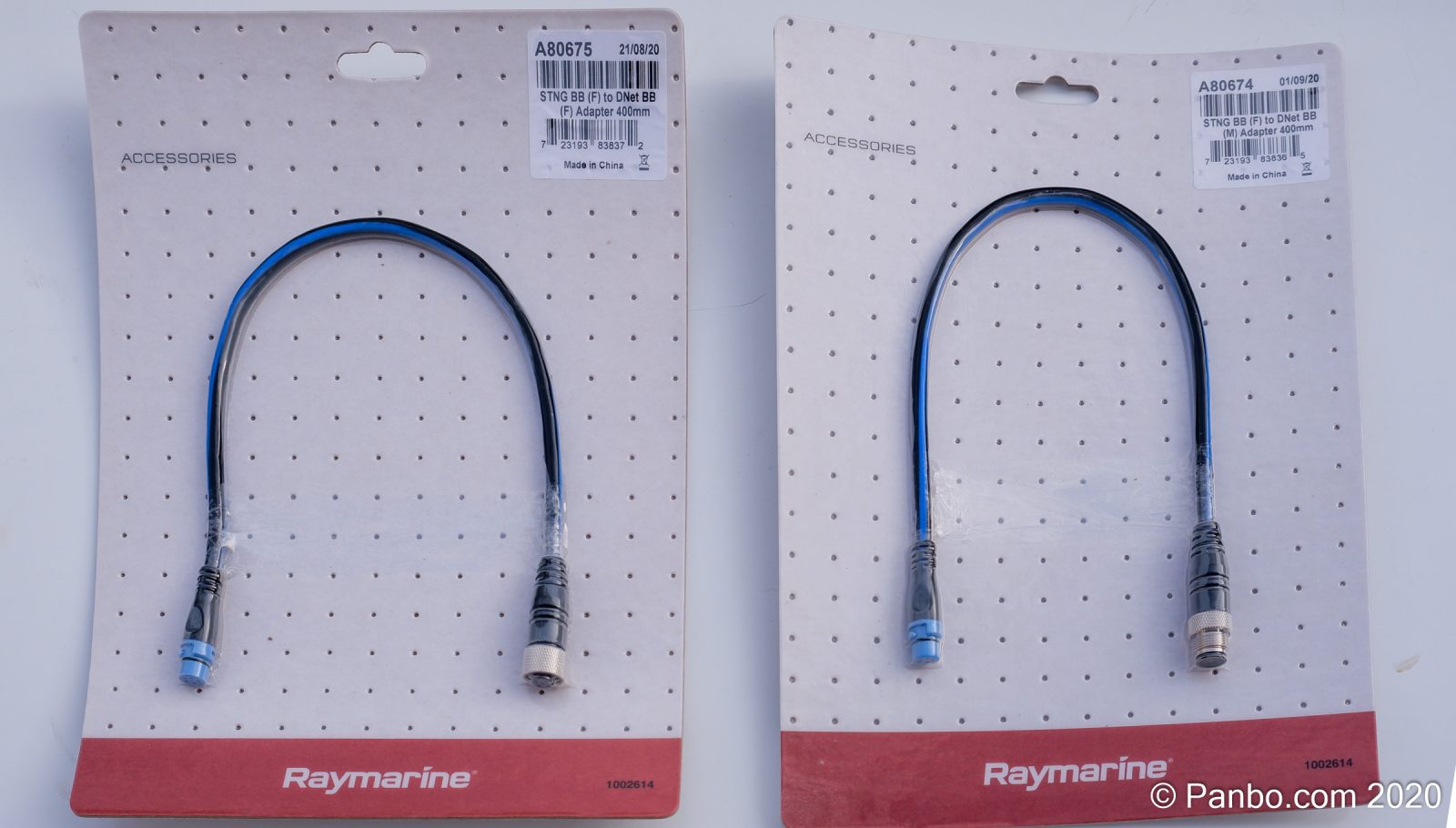
I’d love to provide you links to Ray’s web pages for these adapters, I’m guessing they will appear in the adapter cable section of the SeaTalkNG page soon. It’s always been a mystery to me that Raymarine didn’t offer an STng backbone to N2K plug adapter even though the spur adaptor was available when SeaTalkNG launched in 2007. In fact, on their own forum, Raymarine suggests chopping off one end of STng backbone and standard N2K cables and then splicing the two together. This never seemed like a good solution, so I’m very happy to (finally) see Raymarine offer these adapters. Also, I’d say that Raymarine offering these adapters validates the fact that STng is truly N2K with a different cabling scheme.
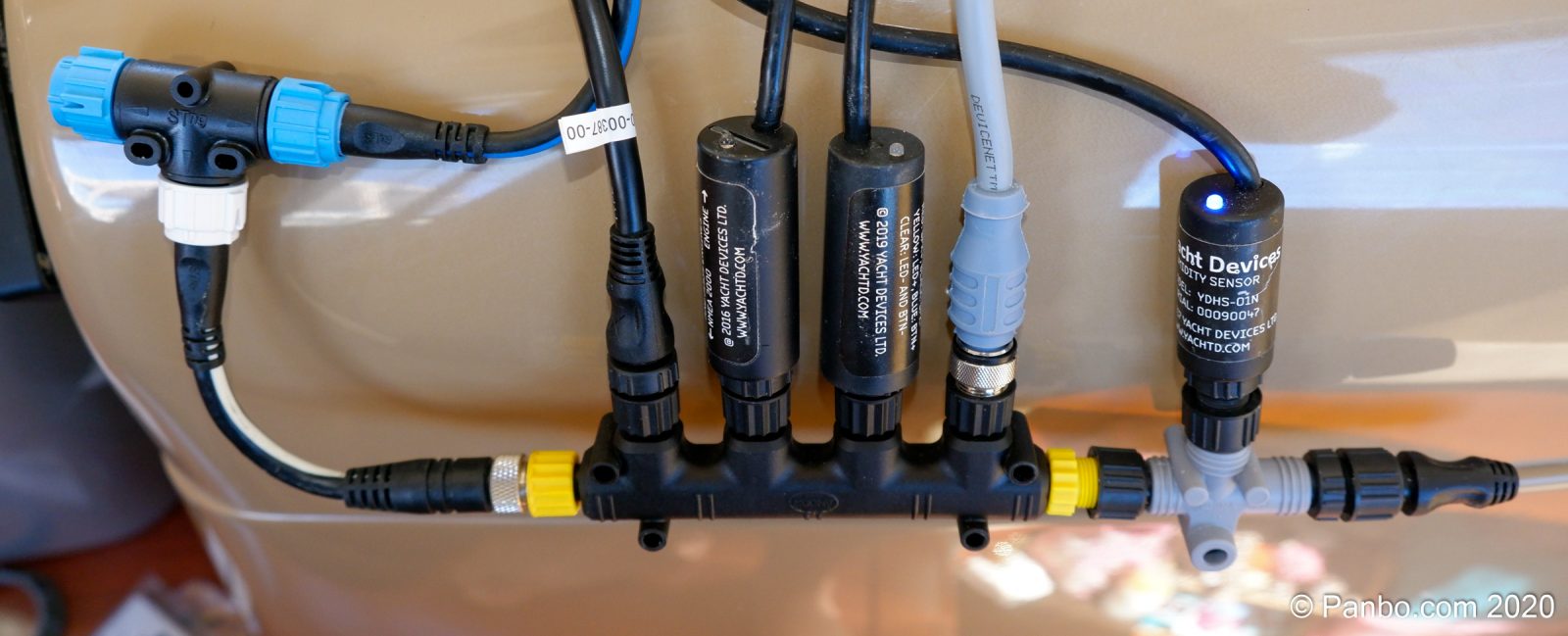
I know this issue well because I built Have Another Day’s first NMEA 2000 network using SeaTalkNG cabling and since then have converted most of it to standard N2K DeviceNet cabling. Thus I learned that there’s an alternative to the backbone splicing method, easier though not any more pretty.
In the top left of the photo above, note the STng tee with the incoming blue-striped backbone cable. But rather than continuing the network through the other backbone port in the tee, I ran an STng/N2K spur adapter cable to the backbone port of an Ancor 4-device tee. From there I’ve connected an additional tee connector and finally a terminator to provide the appropriate termination to the network. The use of the spur adapter has never caused any issues on my network, but it’s always bothered me that I had to rely either on this hack or hand-splicing cables to adapt the network.
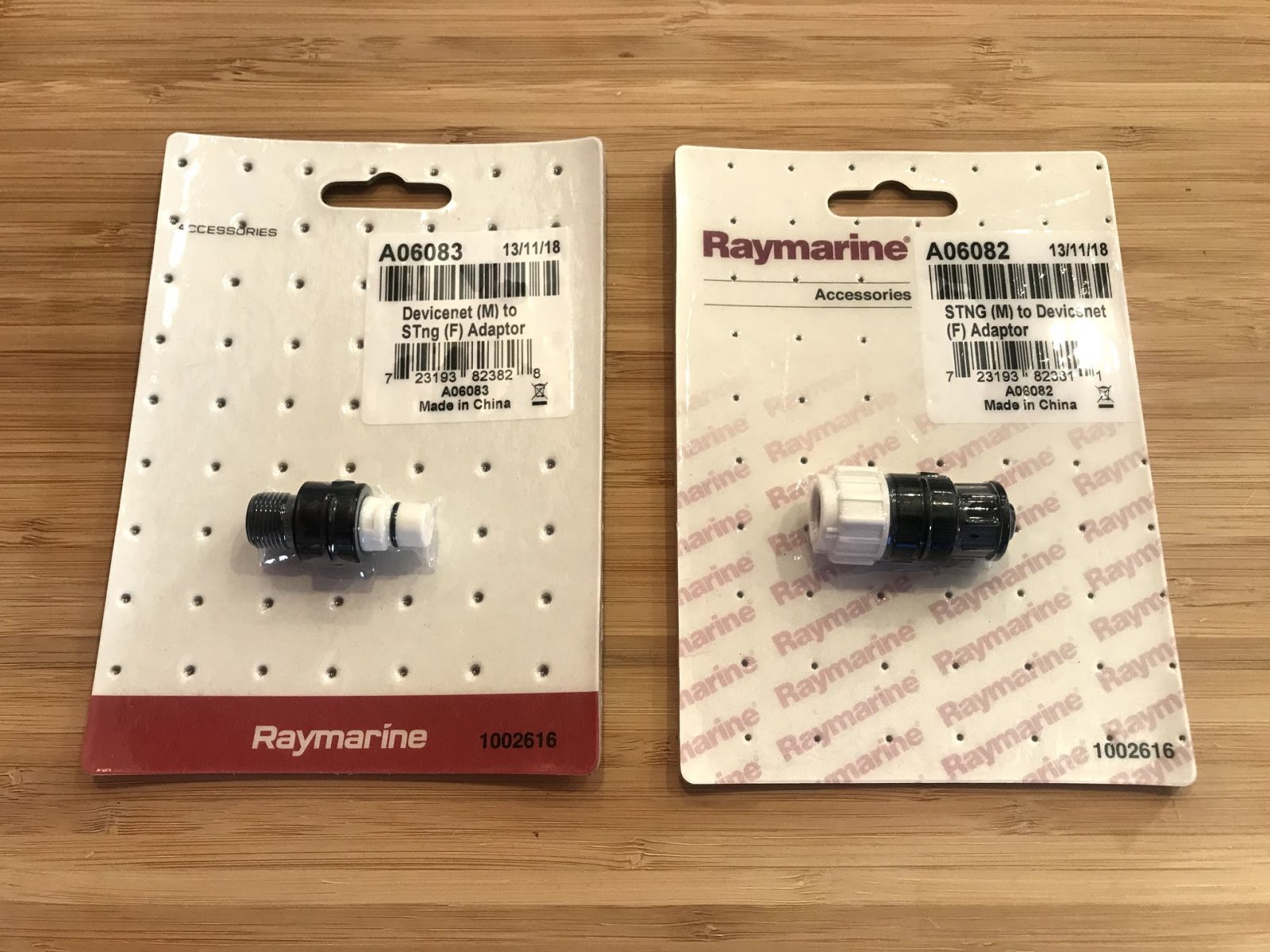
The new backbone adapters join several other STng adapters Raymarine introduced in January of 2019, and along with the many spur adapters also available, I think that Raymarine now has a range that fits just about any need.
I’ve been trying to figure out if Raymarine is moving away from SeaTalkNG for some time. Axiom MFDs all have a standard NMEA 2000 DeviceNet connector on the back, not STng. So, is Raymarine sunsetting STng? I thought so for a while but then I’ve seen new products, including their brand new YachtSense boat control system, with STng connectors. I’ve asked Raymarine about their plans and haven’t gotten a clear answer about where the system is headed.
Although my default position is always to prefer a standard versus proprietary system, SeaTalkNG is definitely not all bad. Raymarine deserves credit for the fact that STng uses larger power wires than standard N2K micro cabling. Plus, STng cables are easier to pull through tight raceways with smaller diameter connectors on the ends of the cables and they’re self documenting with blue stripes down the entire length of a backbone cable and white stripes on a spur cable. So, I’m not sure if STng is going away anytime soon, but I do know that these adapters make it easier to live in a world of both STng and standard NMEA 2000 cabling.


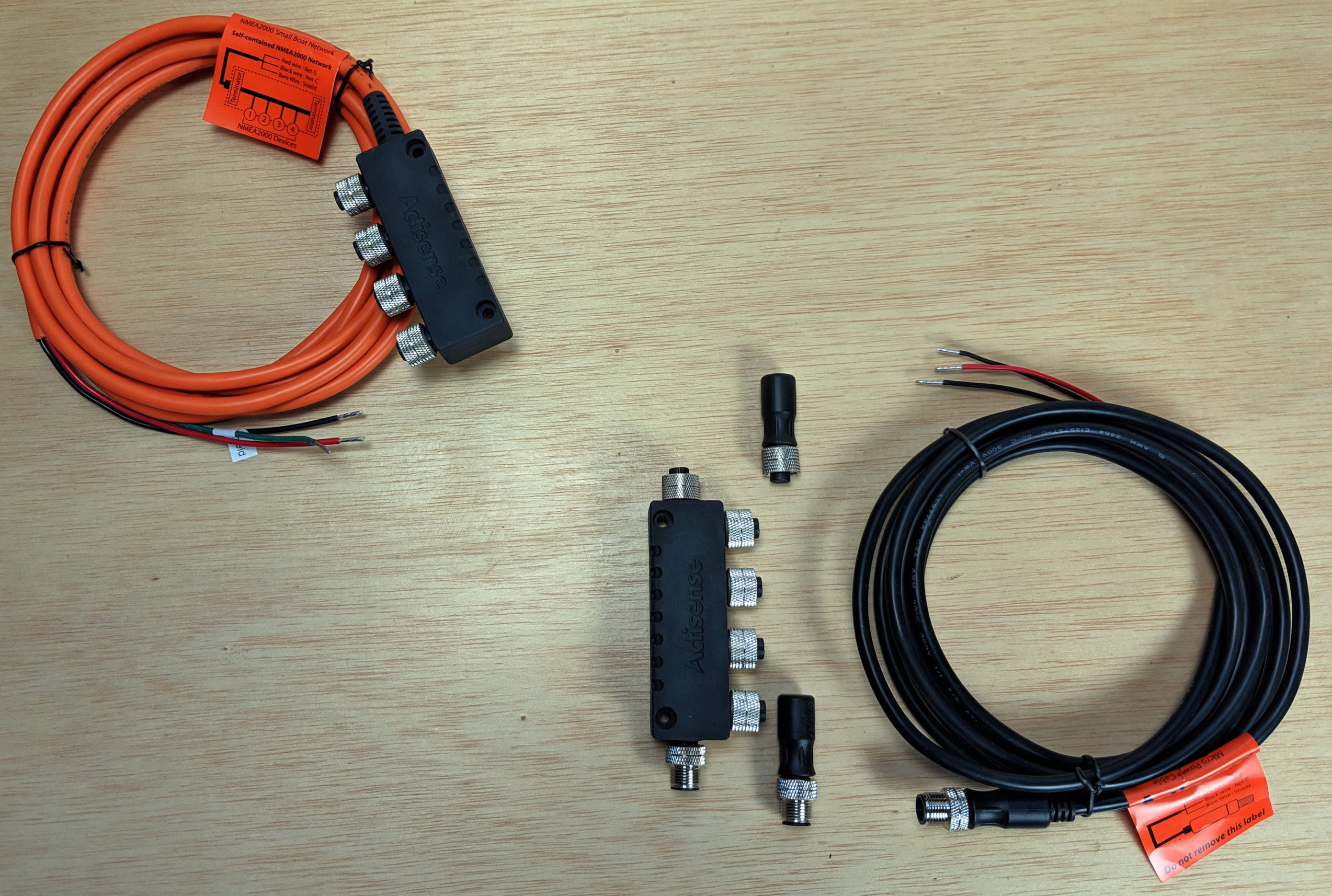

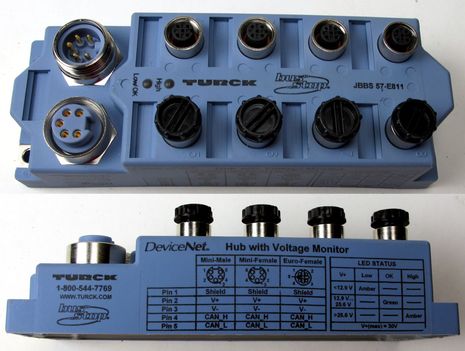








Aleluya!! At my sailboat everything is B&G… but… deep transducer still going through a Raymarine its5. This solves my predicament of cutting a Raymarine backbone and add simnet terminals.
fantastic … only 4 years too late for me any many others!
and cynically, im sure they will be ridiculously priced, its called “proprietery” .. and “we can charge what we do because we can “ …. i dont have a problem with any company generating reasonable (even excessive) margins, but the cost vs selling price on these proprietery cables & adaptors, can at best be termed “extortion” …
Good article Ben!
I order yesterday after reading the article from Hodger marine. $35 each.
Yep, expensive but in my case necessary.
I’m still holding out for NMEA to scrap DeviceNet connectors and adopt STng. (Ha ha)
I think you’re going to be waiting a while… 😉
It’s good that this adapter finally is available, but chopping a SeaTalk ng backbone cable and a micro-C NMEA 2000 cable and soldering them together is a simple and not very time consuming task for anyone with some experience in practical electrical work. I’ve made such an adapter a couple of times for friends. I used heat shrink tubes over the induvidial wires and a heat shrink tube with hot melt glue over the cable jackets, a robust and waterproof solution.
I had not paid attention to Ancor’s line of N2K cables and connectors, but it’s neat that they make separate backbone and drop cables so that a network can be self-documented, and that the backbone cables use 18ga power wires to reduce voltage drop. In fact, looks like they took some clues from STng, except the connectors are all standard N2K regardless of color:
https://www.ancorproducts.com/en/products/wire-and-cable/nmea2000
Bern, thank you for taking the time to document your exploration with these networks. I just took possession of a boat that has a Raymarine Axiom 12 MFD (NMEA2000 with DeviceNet male cable currently unused), a Raymarine ST60+ Depth finder that doesn’t currently communicate depth to the Axiom, and twin Crusader gas engines whose ECM’s output J1939. I’m thinking of trying to bring it all together and maybe add a second Axiom for the engine data using Yacht Devices J1939 to NMEA2000 adaptors. Anyway, your article is timely and I have at least two questions: If I create a combo network of NMEA2000 via the Ancor 4-Tee and in my case the “Raymarine Seatalk1 To Sea Talk-Ng Converter” (E22158), question 1 is where do the terminations go? One on the end of the NMEA2000 Ancor 4-Tee (or a backbone connected after the 4T) and another termination on the end of the SeaTalk E22158? i.e. bookending the combo network? Question 2 is, should this combo network of mine pull power from the Axiom MFD or do I add possibly a second power drop onto either the NMEA2000 portion or the SeaTalkNG portion? In my case all of that stuff will be on the bridge but I expect to run a 10m NMEA2000 backbone to the salon to connect to the AV system and possibly tank monitors, etc
Hi Keith
I am about to install a st1 to n2k conversion pretty much like the one you describe via a E22158 and the stng to n2k backbone adapter cable and I am wondering about the exact two same question as you posted above?
How to terminate?
Which network to power?
Did you figure it out?
BR
Anders
Hi Anders, I did figure it all out and it was easy, I just needed learn enough to have it all make sense. I’ll answer the questions in a straightforward way first, then add a little detail later. First, the termination resistor plugs (quantity two total) go one on each end of the combined network no matter what device is at the two ends. In my case I have an Ancor 2-T on the far end of the backbone down in the salon to pick up my Fusion RA770 stereo, and a Raymarine ITC-5 on the bridge end of the network. I also have an Ancor 4-T on the bridge picking up various devices and the 4-T is physically between the ITC-5 and the 2-T. So, I have one Devicenet termination on the far end of Ancor 2-T and one Raymarine termination on the opposite end of the ITC-5. I added one N2K Ancor power tap in the load center of the network because N2K power does not come from the Axiom MFD. It is equally acceptable to power the N2K network from the E22158, just be mindful of trying to keep the power tap near the load center of the entire network. Read up on Load Equivalency Number (LEN) if you haven’t already. Ok, so here’s a little more detail. I went with the Raymarine ITC-5 instead of the E22158 and moved the depth transducer wires from the ST60+ to the ITC-5 because I want to rip out the ST60+. However, I’m yet to get flawless performance of depth readings from the ITC-5 being displayed on the Axiom 12, I regularly get readings of “0” and am still working on that and about to send the ITC-5 in for warranty replacement. All that to say, using the ST60+ as a “repeater” (don’t forget to change that setting in the ST60+) and using the E22158 is supposedly more robust and I may end up doing just that. I had fun “mastering” N2k and am happy to share more details if you need them.
Hi Keith,
Thanks for the reply and I am happy to read that you have it (mostly) working.
So did I now. By powering only the n2k bus but not the stng bus, as you wrote, I now have the ST60+ (depth, temp, speed and wind) going to and showing fine on my mfd (B&G Vulcan 7) along with also vhf radio inputs inbound from the n2k bus. This is what I was aiming for so that’s great.
The power input is placed as the last T-piece before going to the E22158. I figure that must be center enough for such a small bus.
The st60 modules then draws power from the n2k bus via the n2k/stng backbone converter cable going into the E22158. Marvelous.
Only thing is that the old Raymarine autopilot (st6001) does not integrate with a B&G mfd. I must find a way to live with that 🙂
Also I must remember to check that repeater setting on the st60. I did not notice that there is such a setting.
Again, thank you for replying.
Happy sailing.
BR
Anders
Thanks for an interesting article and discussion.
I would like to cut and solder a n2k and a stng cable together, but which color goes to which color?
I Hope you can help…
Per, I’m pretty sure that Raymarine uses the same color coding as standard NMEA 2000:
White: Net-H, “high” data signal
Blue: Net-L, “low” data signal
Bare: shield
Red: Net-S, 12v DC power supply
Black: Net-C, 12v DC ground
https://panbo.com/n2k-cable-mixing-not-a-big-woop/
But solder joints aren’t considered resistant enough to vibration for boats; you’re supposed to join wire mechanically, like with a crimb butt connector.
Thanks a lot Ben!
I didn’t know that soldering was not a god solution on boats, i have always done that…
soldering is a fine solution if done correctly, however not everyone knows how to solder correctly, insulate the wires properly post joint, and then support the joint properly from a cable restraint standpoint going forward. Impossible to measure skill over a blog thread.
Anonymous, on a boat, in order to comply with safety standards, soldered (and only soldered) joints aren’t acceptable. Properly soldered connections create a joint that is much stiffer than the wire joined. This joint is hence more brittle than the wire joined.
Here’s a quote of ABYC E-11 from Ancor:
“Solder shall not be the sole means of mechanical connection in any circuit.”11.16.3.7. – https://www.ancorproducts.com/en/resources/abyc-standards.
-Ben S.
Im trying to create a similar network, with some key differences in equipment. Trying to tie a Raymarine ST1000 Tiller Pilot into my B&G Vulcan 9, which uses NMEA2000.
I have the Seatalk1 to Seatalk NG converter but am not sure how to connect it all. This article helps in making sense of the equipment, such as the purpose of terminators.
Rick, where are you having troubles or unsure? I’m sure our knowledgable readers can help you out.
-Ben S.
How can I use a bare wire spur cable from RS150
Down hole in rail then connect to backbone ?
Any connector made for this?
Ken
Do you know if Raymarine device net cable nema2000 has a power supply in it or is it strictly data. Don’t want end up with a second power source into my network
Raymarine device net cable nema2000 is fully functional and has all power and data channels.
Ok, so I will have to put a power switch on the vesper AIS or disconnect it’s power source completely so I won’t back feed a second power source into the network
Peter,
I’m not sure I understand. Your Vesper AIS isn’t outputting power on the NMEA 2000 network and expects that the NMEA 2000 network will be powered. Unless there’s something unusual with your installation, or something I’m missing, you won’t need a power isolator or switch.
Best,
Ben
I have a seatalk1 network powered from my ST4000+ autopilot. I also have a powered nmea 2000 network with B&G plotter and AIS etc. I now want to connect these networks by using the seatalk to seatalkng converter and the seatalkng backbone to devicenet cable.
Can I keep both power suplies? or should i remove on? Can the nmea network be powered by the autopilot (seatalk network) through the seatalk to seatalkng coverter? or the other way around to power supply the seatalk network from the nmea network?
Hi Mics,
In your case, a SeaTalkNG (blue) backbone to N2K cable isn’t needed because you don’t have an STng network. Instead, the ST-STng converter can just be a device on your existing N2K network by using an STng spur adaptor cable that’s white on the converter end and standard female DeviceNet on the other.
Your existing N2K network will power the converter and Raymarine says that SeaTalk cable you run from autopilot to the yellow converter port should be unpowered. I’m not sure that you have an unpowered ST port available in your autopilot system but probably yes judging from the various system diagrams in the converter manual:
https://productimageserver.com/literature/ownersManual/44722OM.pdf
PS: I once tested the ST-STng converter cabled the way I described and it probably works even better 13 years later:
https://panbo.com/raymarine-st-stng-converter-hands-on-1-gps/
Hello, Can any NMEA device to connected to the Raymarine Element 7 fish finder.
I want to preserve my Wind and CH wind displays and my ST1 AP Wireless Remote. I want to enter my Wind Machine analog data via this route rather than the iCT5 Analog Transducer Interface as I don’t think the ST STng is bidirectional to the Analog Wind / CH wind heads.
The ST1 to STng looks ideal for the Wind and CH Wind, and Apparent Wind Speed, powered from the STng back bone and data shared onto the STng network.
I read conflicting RM data regarding AP data. I can power the wireless remote base station from the STng backbone. RM even has a schematic including a AP Wireless Remote on a simple ST1 network running through an ST -STng converter, seems in conflict with the install guide. Unfortunately this is typical of RM tech manuals.
So my question, will wind direction and speed and AP control data flow through the ST to STng Converter, bidirectional not required.
Apologies for the long winded question.
Coho, the ST1 – STng adapter is bi-directional, but I don’t know if every data type is passed. For sure things like SOG, Wind, Heading and depth seem to go both ways. I’ve never tried any AP stuff, however.
I removed & replaced all my ST1 stuff and gave away the converter after a lightning event in 2022, so I can’t do any new testing – sorry!
Hartley
S/V Atsa
SV Atsa, Thank you. V helpful to confirm bidirectional info. I suspect the AP Remote is unlikely as the convertor manual says not. The AP Remote connection in some diagram somewhere was probably in error or a new STng unit plugged into one of the 2 spurs on the converter which I missed.
I will settle on the ST60 Wind and CH and add in a ST60 Graphic Display which is currently in great condition having been in the Nav station. Everything else will run through the iTC5 for depth and speed and the i70 displays and the P70S AP control.
Nice to know the Speed and Depth will run back into the ST60 Graphic.
Really appreciate your comment. I never used the AP Remote anyway so won’t fuss with it.
Glad to help, Coho! BTW, I went a similar route after Mother Nature smoked my wind instrument & sender – replaced all my ST60 antiques with i50, i60 and i70, run with an ITC-5. I didn’t change any sensors, just ran them to the ITC-5. Only glitch is that the ITC-5 depth reading get intermittent sometimes (ALWAYS when its shallow, of course!) – I’m not sure if our antique depth sensor is the problem, I haven’t dug into it much (but I know others have had the same issue)
Hartley
On the Depth, I have a Transducer from the ST60, an unused DSM Transducer, and of course the DSM800 with the new i70 instrument pack. I’ll let you know. In Panama and waiting on delivery.